Showcase-Sunday: My Kokoda Trek experience: TWO
Hey y'all, it's time for part two of my Kokoda Trek post series...I know you've been waiting all week!
This is the second part of a series of posts I'm doing on my 2007 Kokoda Trail trekking experience, some history behind the Trail and how it changed my life. You can see the prequel post here and part one here which will give some perspective.
Before I go any further I need to apologise for the images. They are not great. The environment is so humid and hot it plays havoc with cameras and mine kept fogging up. I ended up having to throw it out after the trip as it stopped working. They are as good as I could do and they tell a story I guess.
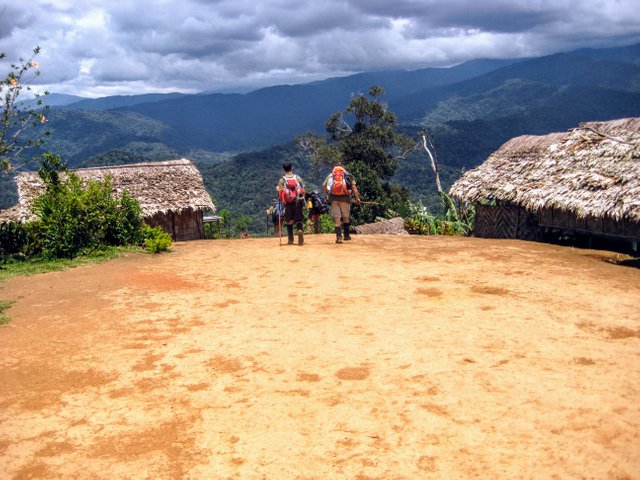
My Kokoda Trail experience started at the Australian Cemetery, the day after a trekking-group briefing with the lead guide; There eleeven of us trekkers. The cemetery was a sombre place full of Australian men who paid the ultimate price back in 1942, many under the age of 20.
The Australian Government caretake this place, together with the Papua New Guineans; It always kept immaculately. Here I signed the visitors book, wrote some words and paid my respects.
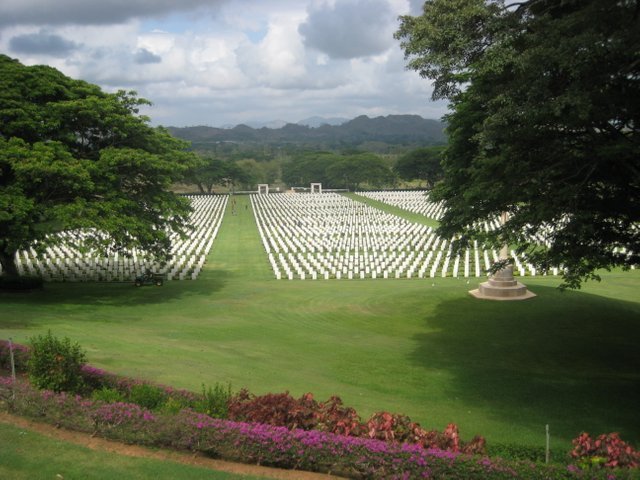
Approximately 600 Australian’s died along the Kokoda Trail with about 1000 wounded in action. Death was often slow and painful. This image shows the Bomona War Cemetery.
The campaign here was brutal and deadly with no respite, no quarter asked or given. Every day could be a soldiers last and if the enemy didn't get you the jungle might. A small wound in the jungle can fester and kill a man, even now, and we were warned to be ultra careful and report all cuts, scratches and abrasions. But in 1942? It would have been terrible.
I read stories of the jungle coming to life as a Japanese soldier would simple appear out of nowhere, stab his bayonet into the chest of a soldier on watch-duty then simply disappear back into the jungle; The Japanese were the best jungle fighters on the planet at the time and expert in moving through the jungle silently and unseen.
Others were shot, mostly in the head due to that being the only part of them visible above the parapet of their weapons pit (fox hole). Many were blown up by shells, mortars and grenades also. As if they didn't have enough to contend with in the Trail already.
The cemetery was sobering, hundreds of headstones stood in perfect rows reminding visitors of the sacrifice these men made. Men. Mostly they were young boys, Aussie sons who will never again set foot on the land they gave their lives for. Like all war graveyards I have visited, this one made we wonder about the futility of it all.
After paying my respects it was off to Owers Corner, and the start of the Trail itself.
In my mind I had a vision of a path-like walk through the rain forest, some water crossings and waterfalls and some incredibly steep ascents and descents. Of course there would be mud and mosquitoes but it all seemed quite achievable...In my mind, before I got there. I'd read many historical books about the war and the Trail and I thought I was ready. I was not.
DAY ONE: Reality check. Chest deep water-crossing within the first hour. Can’t breathe due to the heavy, humid air, sweating profusely and aching shoulders from my pack. Feet hurt and slipped twice. Add wet boots and clothing, an embarrassing (but entertaining to others) slip and fall on the way up the far bank and the terrible understanding that this was the easy part. Only 95km to go.
Putting one foot in front of the other doesn’t seem so hard right? The problem is that the path-like walk through the rain forest I had envisioned was somewhat amazingly more challenging. Despair nagged at the fringes of my certainty and fatigue gnawed at my good physical condition.
At no point could I put one foot in front of the other as per normal. The foot would have to twist one way or the other to slot between snake-like tree roots that resembled a plate of dropped spaghetti. “Step on the roots,” I heard someone mutter. Nope, they're far too slippery - A sure way to end up with a broken ankle or leg. Slipping meant risking injury or death on the steep, slippery, muddy and narrow Trail.
I tried to imagine being an 18 year old, (average age of an Aussie soldier on the Kokoda Trail in the war), carrying a 45kg pack, rifle (Lee-Enfield SMLE .303), 2-3 ammunition bandoleers with 150-200 rounds, grenades, food, water, a mortar or mortar shell, possibly a heavy machine gun (Bren Gun) and other war-like things whilst trying to move through this terrain, look for the enemy, navigate, dodge bullets and shells...Hmm, and this was the “flat part.” they told me, the descent from Owers Corner. The fact people fought a war here seemed unbelievable.
Looking up was almost impossible for fear of misplacing a foot, falling and breaking something. I trudged, rarely taking more than two steps in the same direction due to the need to manoeuvre around the obstacles, the tree roots and twisting path - As a note, the Trail is sometimes footpath wide, sometimes the width of one booted foot and sometimes not there at all, a creek or river. It moves from place to place with the elements and jungle so is more of a general “direction” than a Trail at all. Lag behind and get lost and you’ll be lost for a long, long...Long time.
Getting injured would mean a Medevac by helo, at my expense, several thousand dollars. That's not what kept me going though, it was the thought that back in 1942 they did it tougher - If they could, I would. It was that simple.
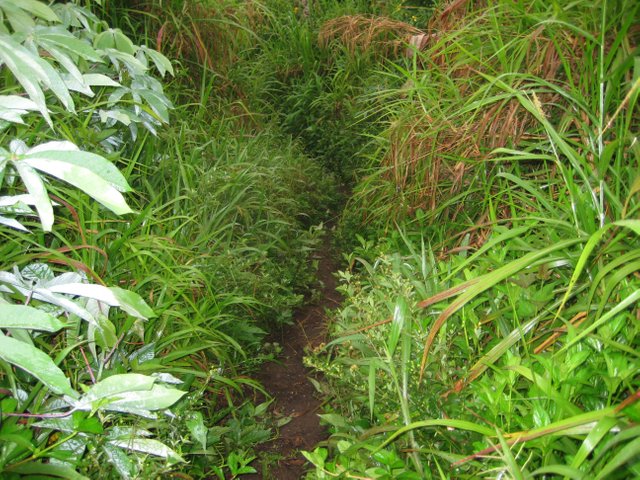
Here's what the Trail can look like, and sometimes there's not even this. There's loads of snakes hiding in the weeds I'm sure. This section lead into a very muddy area, almost knee-deep for about 200 metres. That took hours to get through.
Emotionally at this point I was feeling fine with only the odd, “WTF am I doing here,” moment running through my mind. My emotional and mental challenge was to come though, and it stopped me dead in my tracks.
Walking by myself some 50-100m away from the next nearest trekker or porter I was starting to lose the excitement I had held and felt instead the emotion of what it must have been like in 1942. That feeling stayed with me throughout the whole trek. What was it like for them? I didn’t have to fight a battle today, didn’t have to make camp and dig weapon pits, to stay up most of the night in fear of being killed in my sleep or suffer through dysentery, malaria and jungle fever.
No, for me it was much easier. At camp on night two and into the early hours of the next morning I simply suffered through intense leg cramps and pain. Gaining my mountain legs would take another day of almost crippling leg cramps and back pain. I have scoliosis and so that didn't help much either. Still, I was fit, only 37 years old and mentally tough. (I was to break later though.)
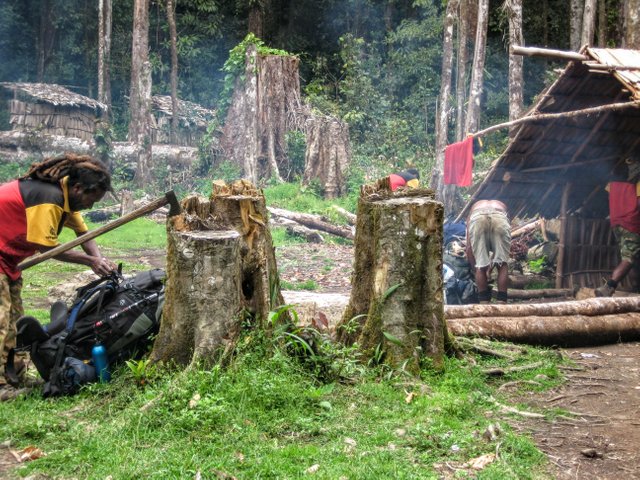
Setting up camp, night three. Accommodation was in an open-sided hut as per the left of shot. Most of the 11 trekkers used their tents but I bunked in with the porters instead, ate with them and basically hung out with them most of the time. They respected me for it, and the other two that did the same. By day 3they called us "brother" and thus, the bond was formed.
In my previous post I mentioned the 39th Battalion and their B Company commander Captain Sam Templeton. He was a well-respected leader, an older soldier placed there to bolster the ranks of very young lads.
Templeton led a patrol into Kokoda and encountered the lead scout elements of the initial Japanese advance. In the firefight Templeton was separated from his force and was never seen again, presumed dead. He was the first casualty of the campaign. Just one story amongst many. His men were devestated, but they fought on in his name, and for the mate beside them. That's what kept these blokes going, and it was my mates that helped me along too.
Eora Creek was renamed by the Australian’s to Templeton’s Crossing. A place in which I felt deeply emotional after having read about the exploits of the 39th there. The image below is of a Japanese mountain gun emplacement above the crossing where they decimated the Australian’s on the opposing mountain side, a mere 200m away.
You can also see some rusting helmets on those sticks. This was a side trek up off the main trail and only myself and two other trekkers did it. It meant an additional 3 hours of trekking, straight up and down, on top of the 9-10 hours we did each day but it was worth it. Brutal, but worth the pain.
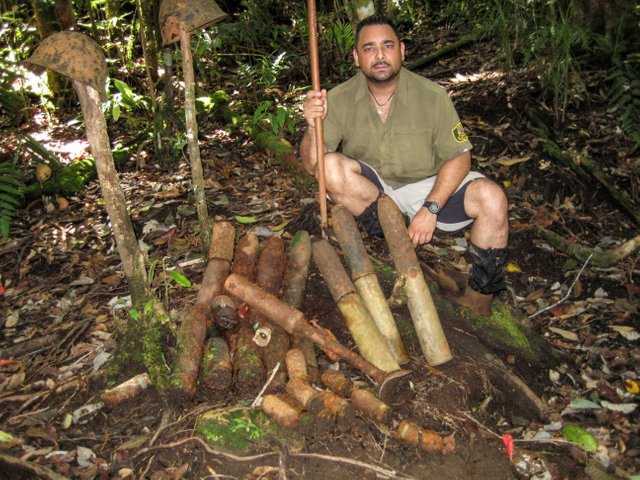
Remnants of the Japanese mountain gun emplacement above Templeton's Crossing. Here we found mountain gun shells, piles of ammunition, grenades, shells, machine gun magazines and more. From here they lobbed shells onto the Aussies, machine gunned them, and got it right back. The story of how this emplacement was finally over-run is a good one - I may tell it someday.
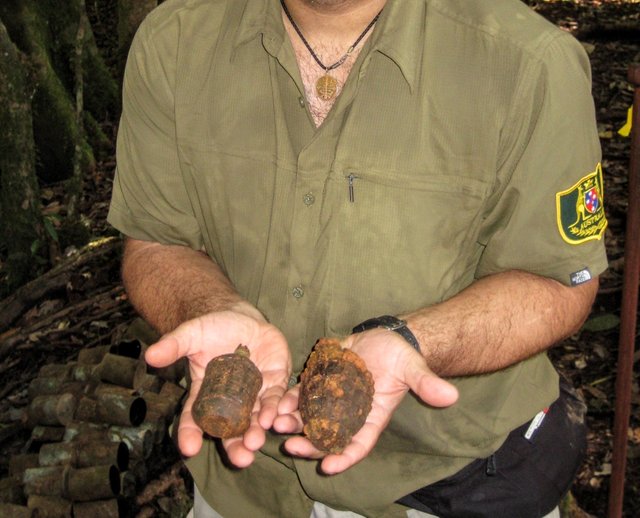
Live Japanese grenade on the left, Aussie one on the right. Picked up at Templeton's Crossing. It might have been dumb picking them up. You can also see spent shell casings behind me. There was a cool bunker complex up here too.
It is a misconception that a trekking group treks together, at least on the Kokoda Trail anyway. Much of it was solitary and I didn't mind, there was little energy for talk anyway as the effort required to trek was so great.
We woke at 5am to eat and take malaria tablets, break camp, gear up and march by 6am. Lunch was around 12 and a halt was called at about 4-4:30pm. When not at lunch or camp it was rare to see another person usually. They were there but in the dense jungle and steep mountains it was impossible to see anyone.
I would go for 3-4 hours without hearing or seeing anyone usually. It was unnerving yet seemed appropriate for my reflections and contemplation. Of course making sure I had ample purified water was important so some thought was given to that survival aspect. Some didn't do so and so went hours without a drink - A sure way to have health issues, but the issues around drinking un-purified water were greater.
At camp or lunch I’d catch my breath and speak with a couple guys I had met on day one called Dan and Peter and our cadre of Kokoda locals. Top blokes all! Peter had the Peter Fitzsimons book Kokoda with him so we would study it, learn about the very section we were on and what had transpired there. We’d also consume loads of beef jerky which was about the only thing I was able to eat as I’d completely lost my appetite. More on that later.
Peter and Dan were good sorts, there for the same reason as me: Respect, and to understand what it took to make the journey now, and back in 1942. Although we didn't trek side by side all the time we offered emotional support to each other and helped get the other guys through. It is a mentally and physically draining trek in itself. Add to that the history of the Trail and it makes for an emotional and very difficult journey. Could I have done it without them? Yes, would I have wanted to? No.
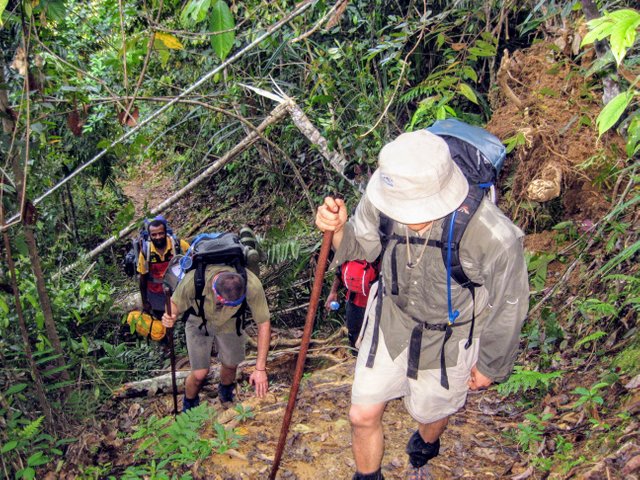
Peter and Dan ascending a typical section. Lead guide is behind - Shouldn't he be in front? That's how it went, there was no real marching order. These two lads became fast-friends from day one, and still are years later.
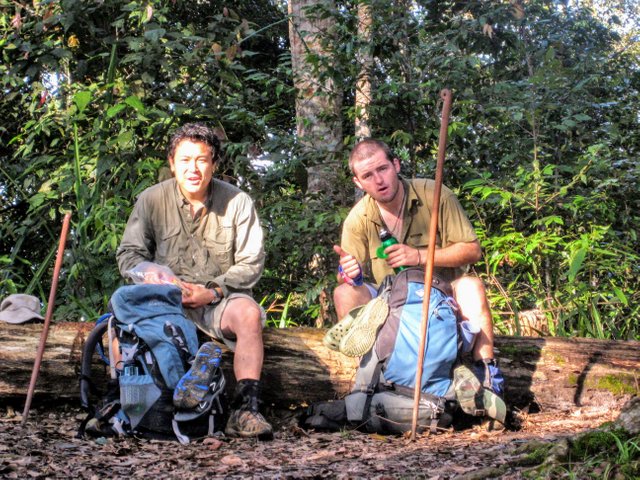
My bro's Peter (left) and Dan (right) - One lives in Sydney and the other in Dubbo...We still see each other occasionally and keep in contact. Strong bonds form on the Trail. Here you see them taking a 5 minute break, as sip of water and handful of trail mix - Keeping hydrated and energy up was of paramount importance. It was up and on before long though.
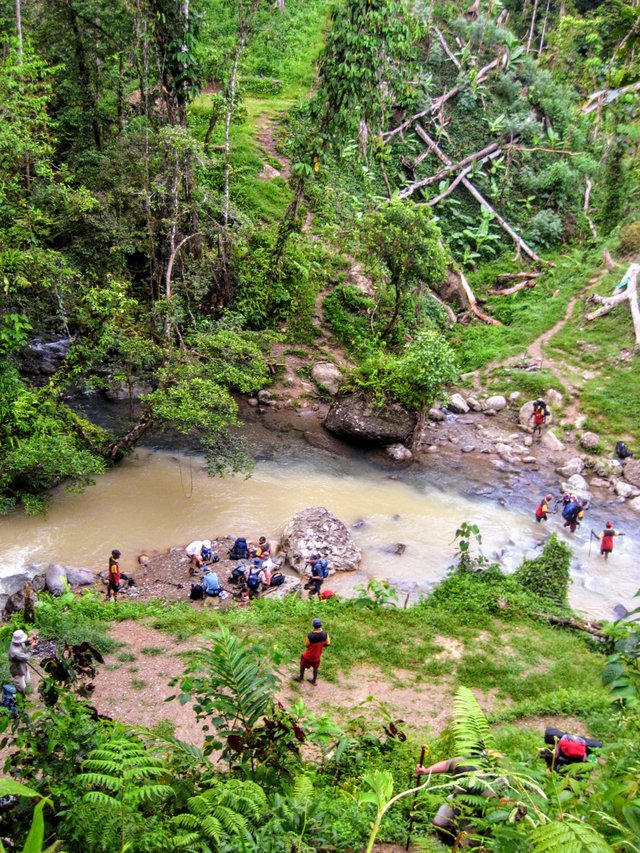
Some of the group down below preparing to tackle one of the steepest and most difficult climbs. I had already begun the ascent and you can see another couple of trekkers just to the right below where I took the photo from. This section was brutal, steep and just kept going up and up. This section, the ascent and descent, almost broke me.
The guides were fantastic blokes. The lead guide had matched us up with one each on the pre-trip briefing the night before we left for Owers Corner.
He paired me up with a guy called Winnie, an intense looking guy, smallish but tough as hell. Quiet but a lot of fun too. Ray was another porter, noisy, extremely inappropriate and quick-witted. Top bloke, who make a great Aussie!
They were Kokoda locals, like all the porters. We all clicked and had a great time along the way. The porters and guides carried some of the camp set-ups and would carry trekkers things as well if required. I carried my own as did Dan and Peter, and we helped with camp set-up and pack-down; It felt the right thing to do. We got to meet their families in Kokoda and spend some time understanding their way of life but more on that in another post.
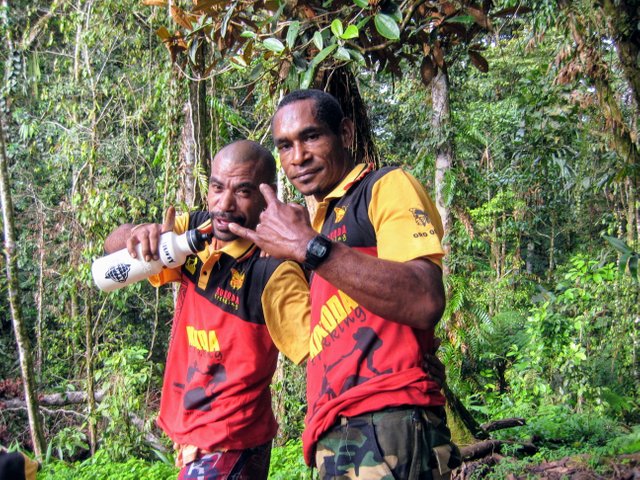
Ray on the left, Winnie on the right. Life in Kokoda is harsh. They are poor people, very family oriented but tough as nails - Living hard does that. These fellas were awesome trekking companions and I am still in contact with them, again, more on that later.
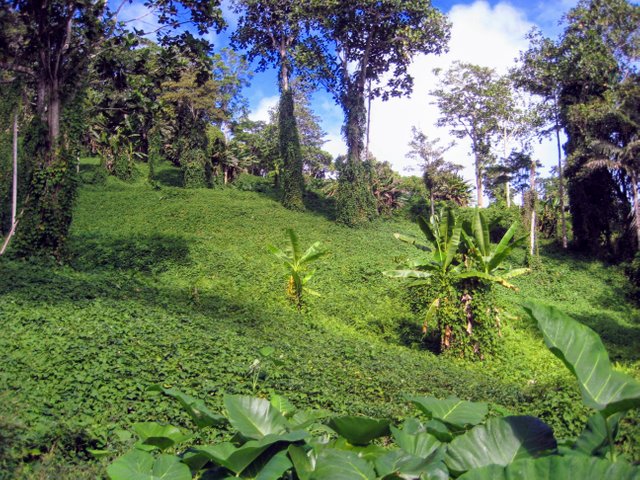
The trail is just ahead, as in you are looking at it! These choko (chayote?) vines hide it completely. I almost fell off a cliff on this part of the trail as the path had washed away and I didn't know because it was obscured. Winnie caught my arm I was good to go. Thanks brah.
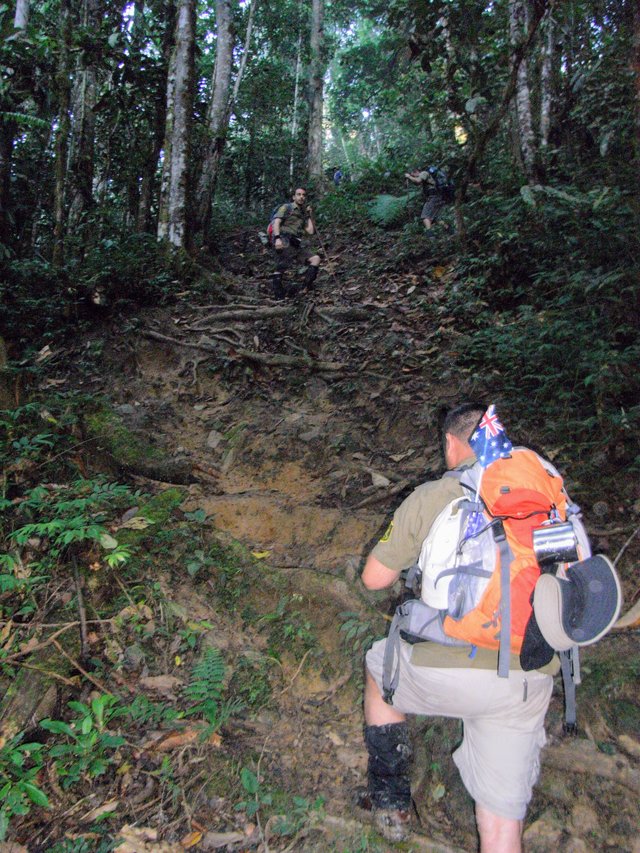
My Aussie flag went everywhere with me and I had little ones, plus small toys and things for the kids as we passed through remote villages. This section was a very tough climb followed by knee-deep mud, lots of it. It was dark and foreboding, steep, slippery, humid and starved of oxygen. Welcome to the Trail y'all. Up ahead you can see a trekker than higher on the right is Dan...He was vomiting from the exertion.
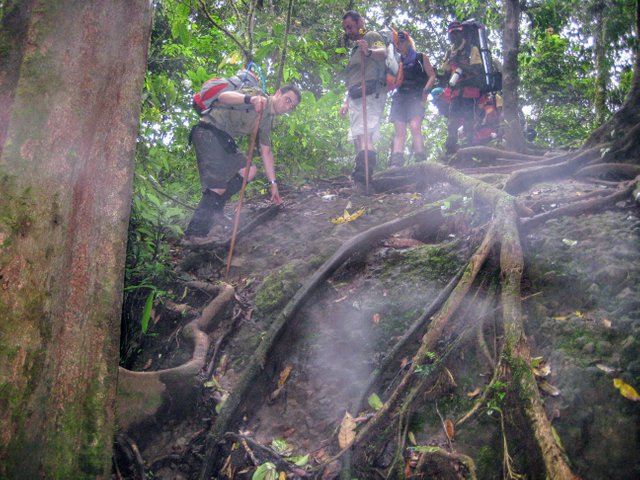
Every ascent meant a descent. Going down was harder on the knees but going up led to false hope; You'd look up and see what looked like the crest only to get there, find a narrow flat section, then look up to see the mountain looming ever higher. Soul-destroying false peaks became my worst enemy. Note the mist in this shot. The heat and humidity was oppressive.
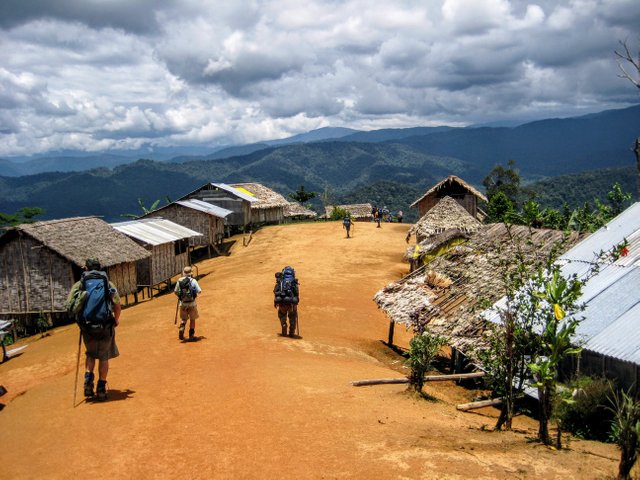
Breaking out from the jungle canopy into the sunlight brought temperatures of 37-40° Celsius. This shot was of us exiting one of the villages in the middle of the day with the sun high overhead. I took little packets of coloured pencils, note pads and some small koala toys to hand out to the kids as we passed through. They live pretty simply up here so the joy on their faces was worth it.
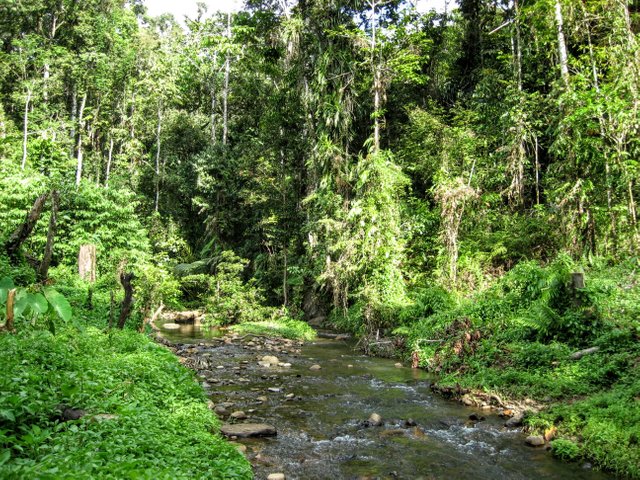
Believe it or not this is the Kokoda Trail. We walked through this creek for about 500 metres and then at a given point that looked exactly like all the others the lead guide just said, "this way" and off we went. It would be easy to get lost here.
Day by day we got closer to Kokoda knowing our last night on the Trail would be at Isurava, the site of one of the fiercest battles of the campaign and one in which the 39th Battalion and 2/27th AIF got to join forces and fight together against overwhelming odds, some 10 Japanese to one Australian. More about that later though.
In this post I wanted to show a few images from the trail itself, to show what it is all about and why it is so difficult. You will never really know unless you go there yourself though. Nothing could prepare you for it, as I found out, and no amount of description could enlighten you.
In my next post I'll write about it and the Australian War Memorial there. It's a special place. I'll also write about Kokoda itself with more images as well.
This post is 3,000 words long and I know that many will never read it all, but that's not why I wrote it; I did it for me, to immortalise my trek on the blockchain, and for fun. Thanks for reading, if in deed you have though.
Tomorrow isn't promised - Design and create your ideal life, don't live it by default
An original post written by a human
Discord: galenkp#9209 🇦🇺
The original post was written and posted by me around September 2017. This post has been reworked it with some 1500 extra words and reposted for the @nonameslefttouse #showcase-sunday concept.
Epic story and well written, I enjoy reading the photo captions the most.
Thanks mate, yeah I figured that would be the case with most and why I expanded the out with some extra detail. Moving forward I may make it a row of photos with solid text on each. Thanks for commenting. 😁
I was thinking of doing the same to my photos on my next wednesday post, so it ws good see the effect on your post.
It's a good way to go I think, provided one puts enough information. No point doing this...
Bus stop
I'd certainly turn off pretty quickly with posts like that which, of course, there are many. If done right I think it could be a good way to go.
src
I imagine that the trekking journey must be so hard and challenging the way you described them here. I like how you self motivated yourself with "those lads had it more harder than me last time, I can do this, I got this lot easier than them 18years old soldier at war". The fact that they took Captain Templeton in the beginning and left the young soldiers without their veterans leader, with their smaller numbers against enemy 1:10 ratio, against all odds and still won the war sounds magical to me. Would you post about how they tackle the Japanese soldiers in the next post? On the side note, perhaps I'm biased,I find man tend to challenge themselves through challenging experience that will cost them their life if the odds is against them as if those experience serve as rite of passage from boyhood to manhood. From your writing you just wanted to know how to be on those soldiers shoes at war last time and I'm sure you learn and grow from those experiences too. I think you were a soldier in one of your many past lifetimes. Haha
Yes, the trek was quite demanding but keeping a positive mind and the right attitude saw me through.
I will talk a little more about some of the battles but the campaign was months and months long so very difficult to cut down for steem-sized posts. I will talk about it a little though.
Thanks for taking the time to read and comment and I hope you enjoy the next instalment in a week.
!ENGAGE 30
@cryptokannon you have received
30 ENGAGEfrom @galenkp!View and trade the tokens on Steem Engine.
Hola. Me cansó caminar esa selva contigo, sólo leer y quedé extenuada. Bien interesante ese viaje. En serio, lo disfruté aunque la realidad me daría miedo.
HI there, thanks for your comment. Yes, I understand how it could bring fear for many, especially if trekking in places like this is not something one has done before. It is reasonably safe although I took out additional life insurance just in case. It was an amazing trek though, and one I would repeat...If I was fit enough.
Thanks again for commenting, and reading the post in the first place.
!ENGAGE 25
@antoniarhuiz you have received
25 ENGAGEfrom @galenkp!View and trade the tokens on Steem Engine.
WHYY DID YOU PICK THE GRENADES UP D:
And also did you go for a rainforest hike BEFORE you went on this one? I'm going to hazard a no as while you may be emphasising to readers who haven't been inside a rainforest before how "interesting" it can be walking through them, you sounded mildly surprised about it to me XD
I lived in Cairns, far north Queensland so am fairly familiar with rainforests I'd say. This wasn't a hike, it was a trek; There is in fact a difference. There was no surprise about the rain forest, I'm just trying to write in a mildly interesting way. I could be more pragmatic of course, but that wouldn't be as interesting I think.
I have trekked all over the world, had a lot of experience with rain forests, and just about every type of environment, but looking like a know-it-all wasn't the way I wanted to come across. I've spent my life in the outdoors doing stuff like this, but writing it matter of factly didn't seem the right way to go...It's not a guidebook or training manual. I've read many of those and never really found them engaging.
I picked up the grenades as I knew they would not go off. They were rusted up and the fuse mechanism, after so many years would not operate. Sure, they're still explosive, but I took a punt they would not do so in the 20 seconds I had them in hand. I've had some experience in this area so it was all good. I survived.
Hi @galenkp, your post has been upvoted by @bdcommunity courtesy of @hafizullah!
Support us by setting us as your witness proxy or delegating STEEM POWER.
JOIN US ON
I read every word for sure sir galenkp, very impressive or I should say Oppressive! Man, just brutal. I think you did a great job of describing it and giving us an understanding of what it is and was like.
I bet it wasn't a walk in the park for those guys when they made the movie about it either.
The movie was actually made here in Australia, in the rainforests of Queensland; I think logistically it was not viable. I'm glad you liked the post. I added over 1500 words from the original who h gave better detail and I think it reads a lot better than the original from years ago. Thanks for taking a look.
It's such an inspirational story sir galenkp and you do a great job with it!